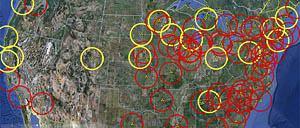U.S. Nuclear Power Plants, safe distance?

Are you wondering what is a safe distance to live from a nuclear power plant?
FULL SIZE map of U.S. Nuclear Power Reactor Locations
I’ve drawn 100 mile radius zones around the nuclear power plant locations. This will put perspective on it. More about this below…
——————————-
Note: Potassium iodide tablets – a thyroid blocking medicine used in a nuclear emergency.
Potassium Iodide Tablets, 130 mg (14 Tablets)
(view on amzn)
——————————-
Map of U.S. Nuclear Reactor Locations
Back during the time of the nuclear reactor meltdown disaster in Fukushima Japan, I put together a location map of the current (and decommissioned) nuclear power plant / reactors in the United States.
Without discussing For or Against nuclear power, it may be smarter and a better use of time to learn some lessons from what happened in Japan that led to the the Fukushima meltdown. To consider the potential risk for those living in the U.S. near one of these reactors – should a worst-case-scenario ever occur.
The problem at Fukushima: All electrical power was lost to the plant (earthquake – tsunami – backup generators destroyed – battery backup dead). This led to a lack of cooling of fuel rods in the reactors, which then led to a meltdown situation.
The underlying issue was a complete lack of electrical power, power sufficient enough to run the powerful cooling pumps.
The Importance of a Geiger Counter
Note: A Geiger counter / nuclear radiation detector will be an important asset during a nuclear disaster!
GQ GMC 500Plus with Dosimeter
(view on amzn)
[ Read: 5 Nuclear Radiation Detector Choices ]
Some of the “What if” Risks
Taking a simple look at the risks that may exist around any nuclear power plant, including the locations in the U.S. map above, the worst-case-scenario is always going to be one where the ‘issue’ leads to complete power failure. Without electricity, any one of these nuclear reactors will melt down, just like Fukushima, or worse.
We would like to think that a nuclear power plant is designed and constructed with the utmost highest regard for for safety.
However, I still cannot help but think of several ‘what if’ scenarios:
What if a ‘Carrington Event‘ solar flare were to occur, like what had happened in 1859. Astrophysicists know that it WILL happen again, it’s just a matter of when. If an extreme solar event like that were to take down the electrical power grid, and-or damage electronic systems from its EMP effects, how long would it be before any, some, most, or all of these nuclear power plants would runaway to meltdown?
What if a true EMP weapon, or weapons, were to detonate and take down all electrical systems of a region, or wider, what then? Are the backup generators and their associated electrical control systems impervious to EMP-type effects for example? What about the control systems of the reactors themselves, are they EMP proof?
Okay lets continue with more “what if’s”…
The New Madrid fault zone. What if it were to unleash a magnitude 9+ earthquake, which geologists agree is possible. Then how would the nuclear plants avoid catastrophe at the reactors in northern Arkansas, eastern Missouri, or others nearby?
The San Andreas tears loose in California. How will Diablo Canyon and San Onofre handle it?
What if there is an unforeseen ‘physical’ attack on one of these reactors? What can the containment vessels withstand with regards to missiles of various strengths?
A cyber ‘virus’ attack along the lines of the Stuxnet computer virus that attacked the Iranian nuclear development facilities?
100 mile radius zones on the map (linked above)
These simple questions led me to create a map of all U.S. nuclear reactors, both operational and decommissioned, so as to have a look where the danger zones ‘might’ be, should a worst-case-scenario occur.
It is difficult to answer the question, “How far away is a safe distance from a nuclear reactor?”, so I’ve created 100 mile radius zones (200 mile diameter) around each nuclear plant to provide some visual perspective. Yellow zones are around decommissioned plants.
Remember, it’s all about the wind direction too. The prevailing winds in the U.S. are typically from west to east while normally dipping down into the south-central U.S. before bending back up the east coast.
